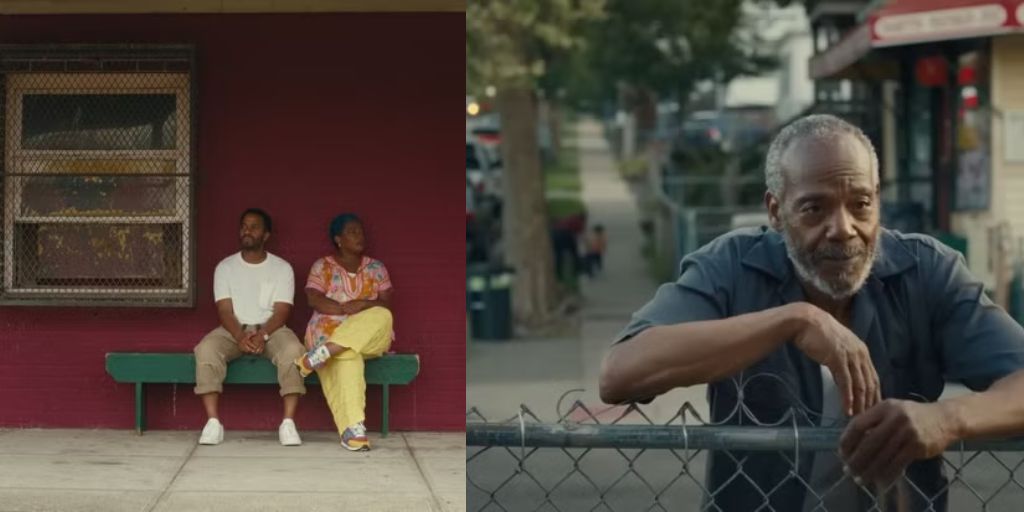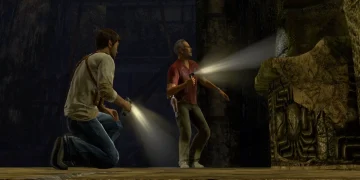Telling stories about generational trauma is a delicate challenge. Many films attempt to address this complex issue, but they often end up portraying one of two extremes: either the trauma is too easily overcome, or it permanently tears the family apart.
Both of these outcomes rarely reflect the reality of how trauma affects families. In life, trauma doesn’t just disappear, and family ties can’t be broken so easily. People can’t escape their trauma, and they can’t truly escape their families either.
With this in mind, it’s clear that telling a story about generational trauma in a truthful and meaningful way is no small task.
Exhibiting Forgiveness manages to do so by skillfully facing the complexities of healing, offering a depiction of a family struggling to reconcile their past while acknowledging the difficult reality that true healing is not easy or immediate.
Titus Kaphar’s Exhibiting Forgiveness focuses on Tarrell, played by André Holland, who returns to his childhood home with his wife, Aisha (Andra Day), and their son. They arrive to help Tarrell’s mother, Joyce (Aunjanue Ellis-Taylor), pack up the house.
Upon arrival, Tarrell is confronted by his estranged father, La’Ron (John Earl Jelks). This reunion forces Tarrell to face the trauma and abuse he suffered at the hands of his father while grappling with the painful contrast between the man he once knew and the man his father is now.
Tarrell, like Kaphar, is an artist who communicates through his work, using evocative images to express complex emotions. Kaphar’s unique perspective as an artist translates perfectly to the medium of film, allowing him to tell a deeply personal story with sensitivity and emotional depth.
The Reality of Generational Trauma in Exhibiting Forgiveness
In fictional stories, there’s often a tendency to conclude with a neatly satisfying ending. Audiences frequently seek closure or catharsis, which can result in unrealistic depictions of generational trauma and healing. However, real change is rarely instantaneous.
Years of pain and suffering don’t disappear simply because someone says they’re sorry. Exhibiting Forgiveness avoids this mistake by showing a more grounded and honest depiction of trauma and healing. Kaphar is fully aware that the wounds from past experiences don’t simply vanish after an apology, and he brings this to the forefront of the film.
When we first meet Tarrell, it’s clear what kind of person he is. He is a successful and influential artist, but he is also a devoted father to his son and a supportive husband to Aisha, who has sacrificed her own career to focus on their family.
Aisha is a musician and performer, but her professional life has taken a backseat to their family’s needs. This sacrifice is a key aspect of the film, as it sets the stage for the family dynamics and reveals Tarrell’s deep desire for balance and equality.
This is especially important to him because of his own childhood experiences. While Tarrell is an accomplished artist, he is also determined to be a different kind of father than the one he had. He is committed to being emotionally present for his son and ensuring that his son has the opportunity to experience a childhood that he himself never had.
As the story unfolds, we learn more about Tarrell’s upbringing and how his relationship with his parents, particularly his father, shaped who he is today. Although Tarrell loves his family, there is a lingering tension and difficulty in reconciling his past with the man he has become.
One of the first challenges Tarrell faces is the pressure to do another art exhibition, suggested by his pushy art agent, Janine (Jaime Ray Newman).
Although Tarrell is reluctant, he knows that he hasn’t fully stopped painting, but he is also deeply aware that his wife, Aisha, has had to put her own career on hold to support their family. This situation is symbolic of the delicate balance between personal ambition and family responsibilities that Tarrell constantly tries to maintain.
The Challenge of Forgiveness in Exhibiting Forgiveness
Despite the film’s title, forgiveness is anything but easy for Tarrell. When he finally comes face-to-face with his father, all of his childhood trauma resurfaces. The memories of the abuse and neglect he suffered are overwhelming, and he is haunted by nightmares.
These recurring dreams fill him with anxiety and panic, and he is unable to escape the emotional scars that his father left on him. His father, La’Ron, is a living embodiment of those painful memories. When they meet, Tarrell’s reaction is one of irritation and resistance. He is not ready to forgive his father, and Kaphar doesn’t try to force a quick resolution.
Rather than offer a simple narrative of forgiveness, Kaphar gives us a much more realistic and nuanced portrayal of the process. The film makes it clear that just because Tarrell learns more about his father’s painful past does not mean that he is ready to forgive him.
Understanding the reasons behind his father’s actions doesn’t erase the hurt that has been done. Tarrell’s struggle to forgive is a central theme of the film, and Kaphar is careful not to offer any easy answers. The pain of the past remains with Tarrell, and healing is a slow and complicated journey.
The film’s realism in addressing generational trauma is what makes it stand out. Kaphar doesn’t sugarcoat the experience of healing. There is no magical moment when everything is forgiven and forgotten. Instead, the story shows the ongoing struggle of trying to reconcile the past with the present.
Tarrell’s journey is one of understanding, but that understanding doesn’t instantly make everything okay. The scars of the past continue to affect him, and it’s clear that he is far from being able to fully forgive his father, no matter how much he may try.
A Masterful Performance by André Holland and John Earl Jelks
While Kaphar’s storytelling is undeniably powerful, the performances of André Holland and John Earl Jelks upgrade the film to another level. Their portrayal of Tarrell and La’Ron is a masterclass in acting. Both actors bring a raw emotional depth to their roles, making their characters’ pain and struggle feel real and relatable.
John Earl Jelks’s portrayal of La’Ron is especially noteworthy. He is able to convey the complex emotions of a father who is trying to make amends, but also an addict who has been consumed by his past mistakes. La’Ron’s regret and desire to reconcile with his son are palpable, but so are the lingering effects of his addiction.
In one particularly powerful scene, La’Ron recounts the cruelty of his own father, telling Tarrell how his father’s abuse shaped him. La’Ron tries to justify his actions by claiming that his tough love made Tarrell the man he is today.
This type of rhetoric, common among older generations, highlights the toxic cycle of abuse that has passed down through the generations. Jelks plays this scene with heartbreaking sincerity, capturing the tragic contradiction in his character: a man who believes he is doing good while perpetuating harm.
André Holland’s performance as Tarrell is equally compelling. He conveys the emotional weight of Tarrell’s experience with subtlety and depth. While Tarrell is a successful artist and a loving father, he is also deeply scarred by his past.
Holland expertly portrays the conflict within Tarrell: his understanding of his father’s pain, his love for his own son, and his inability to forgive his father. The emotional tension between Tarrell and La’Ron is palpable in every scene, as Holland’s portrayal shows the deep, unspoken pain that Tarrell carries with him.
The Complexities of Family and Healing
At the film’s climax, a tragedy strikes the family. However, rather than serving as a moment of reconciliation, this tragedy pushes father and son even further apart. This is a crucial moment in the film, as it emphasizes that time does not heal all wounds.
Exhibiting Forgiveness shows us that some pain remains with us, and that healing is not a linear process. The family does not come together in a moment of catharsis, and past mistakes are not easily forgiven. The trauma of the past continues to haunt the characters, but there is a sense that the anguish is not permanent.
The film offers a form of peace, but it is not the traditional fairy tale ending. It is a peace that comes with acceptance of the complexity of family relationships and the understanding that healing takes time.
The final moments of the film highlight this reality. Although Tarrell and La’Ron come to a certain level of understanding, it is clear that their relationship will never be the same. The past cannot be erased, and Tarrell cannot forget the pain his father caused.
However, there is a glimmer of hope in their relationship, even if that hope is uncertain and fragile. The film doesn’t offer a neat resolution, but it does show that there is room for growth and healing, even if it’s not immediate or perfect.
Titus Kaphar’s Artistic Vision
Titus Kaphar’s talent as an artist shines through in Exhibiting Forgiveness. While this is his first feature film, Kaphar’s background as a visual artist informs his storytelling.

The film shows themes of family, art, and societal privilege, drawing from Kaphar’s own experiences. In particular, the film touches on the tension between artistic success and personal growth, as well as the way that art can both reflect and shape identity.
Ultimately, Exhibiting Forgiveness is a raw, unflinching look at the complexity of generational trauma. Kaphar doesn’t try to simplify the experience or offer easy answers. Instead, the film presents an honest portrayal of a family struggling to heal, showing that forgiveness is not an immediate solution but a long and difficult process.
With stunning performances and a nuanced scheme of trauma and healing, Exhibiting Forgiveness is a film that will resonate with anyone who has ever tried to reconcile with their past.




